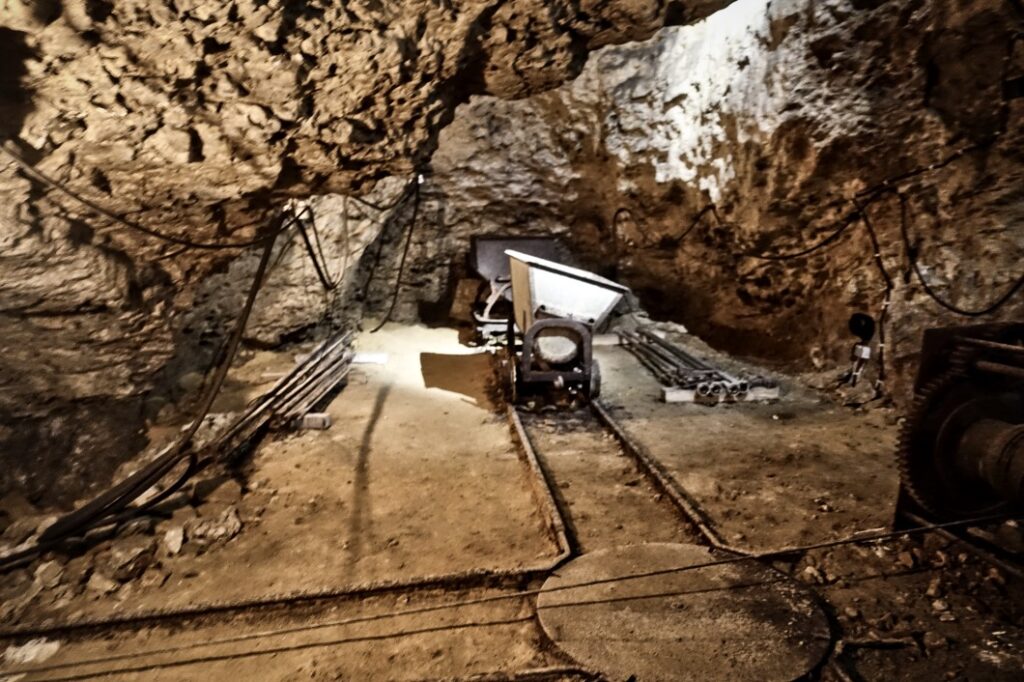As a child, I used to walk along the Pottensteiner Weg and only realised years later that there really is a place called Pottenstein. It is located in Franconian Switzerland between Nuremberg and Bayreuth and it made sense to stop here and visit the Devil’s Cave near Pottenstein.
About the Devil’s Cave near Pottenstein
In 1922, geologist Hans Brand drilled a hole in a wall a good 9 metres thick in the Devil’s Hole and discovered the Devil’s Cave. Previously, there was only one enormous cave portal here, about 25 metres wide and 14 metres high. The so-called Devil’s Hole ended after a depth of 85 metres.

The natural karst cave could be made accessible to visitors. Since 1923, beautiful stalactites can be admired here. In the course of 8 years, further cave rooms were opened up, which are connected to each other by galleries. If you add up the length of all the passages, shafts and galleries, the cave stretches over 3000 metres.
The show cave is 1700 metres long, and about 800 metres are visited during guided tours. Every year, 140,000 visitors come to the Devil’s Cave, making it one of the most visited show caves in Europe.
In addition to the show cave, there is also a cave laboratory and the Teufelshöhle therapy centre in the extended side galleries.
Guided tour through the Devil’s Cave
Anyone wishing to join a 45-minute guided tour of the dripstone cave can buy their ticket at the cave entrance. Tours are offered at regular intervals, which are limited by the number of visitors but start in a tight rhythm.
A bell rings to signal that the tour will start a few moments later. At the entrance there are a few more safety instructions and then the door to the devil’s cave opens.

You should be reasonably sure on your feet and also be able to climb stairs. The tour runs over three floors on easily accessible paths and many stairs – there are over 400 steps in total! There are railings everywhere, but you should still be careful, the floor is damp and the ceilings are not always high enough.
In the Devil’s Cave, the air temperature is quite constant, between 9 and 10°C. It makes sense to wear a jacket or jumper! The relative humidity is very high at around 95 – 98 percent.
What can you see in the cave?
The tour begins in the dome hall. In addition to many explanations and stories about the cave, there is a small exhibition of mining tools. A small programme with music and light effects is also played here. It remains to be seen whether this is absolutely necessary to make a cave more interesting. The visitors around me liked it, I could have done without it.

We continued through the breakthrough into the branching cave system. From that point on, the guide draws attention to the wide variety of stalagmites and stalactites that have grown over thousands of years. Many of the stalactites have been given names, which in most cases have something to do with the appearance of the arrangements. For example, you can see a pope’s crown, an organ or a curtain.

But it is not only stalactites that have been discovered in the Devil’s Cave near Pottenstein. The path led us further into the bear caves. Bones of cave bears have been discovered here and a skeleton (the animal is said to have lived 30,000 years ago) stands here for the visitors.

Through a connecting passage we then reached the Nibelungen Grotto and the Barbarossa Cathedral. First there was another little light and music interlude and only then did we have some time to take a closer look at this varied cave. The Barbarossa Dome is the centre of the cave and looks like a pagoda-shaped stalactite. The stalactite is about 1.20 metres high and is estimated to be 200,000 years old.
There are countless small and large stalactites in this cave, which have a wide variety of shapes. I found this part of the tour really very impressive. I think it’s a pity that you hardly have time to discover everything at your leisure. The guide keeps asking you to go further and at some points during the tour you could already see the next group coming.

The visitors’ path climbs 115 steps up Calvary. There stands the crucifixion group. These three stalactites are interpreted as the trunks of the cross, the smaller stalagmites in front of them are the people watching.

Through a connecting tunnel you then reach the Three Emperors Grotto. The three large stalactites there are said to be 250,000 years old.
After walking downhill again, you reach the Giant’s Hall, the largest room in the visitor cave. Here I was really impressed by the so-called tree. This dripstone formation is said to be about 340,000 years old and has now reached a size of about 3.5 metres. The tree crown is formed by small tubes, the trunk is the stalactite and there are also “roots” which, when illuminated, give the whole tree an interesting appearance.
Even in this room, there is hardly enough time to discover all the subtleties and to pay enough attention to the small and large natural spectacles.
We go up a staircase and can thus still see the room from above. Then we leave this section of the cave through a very narrow passage behind the tree.

Through narrow passages past smaller stalactite formations you finally reach the exit of the cave.
This is not identical to the entrance! It lies about 25 metres higher in a gorge like a ravine. It is an impressive view when you arrive here. We took our time until the rest of the guided tour had left, so we could enjoy the path through the rock labyrinth.
After a good 10 minutes downhill, you arrive back at the entrance level.
Is it worth taking part in the guided tour of the Devil’s Cave near Pottenstein?
I found the guided tour through the Devil’s Cave near Pottenstein very interesting. It’s a guided tour that everyone can take part in and that is also suitable for children because of its length.
You shouldn’t expect a scientifically sound lecture on the formation of stalactites, but what is said is generally understandable.
I would have liked more time at some points to be able to look a little closer. But, when I observed the other visitors, they had enough time. They rushed ahead and so sometimes I think some did not notice the beauty and the incredible achievement of nature.
But if you go on the tour with your eyes open, you will discover a lot of beautiful stalagmites and stalactites in addition to the highlights told by the guide.

Address:
Bundesstrasse B470 about 2 km outside the town of Pottenstein (91278 Pottenstein).
There is a large free car park in front of the cave.
Opening hours:
Beginning of November – end of March:
Sunday: 11.00 – 12.20 – 13.40 – 15.00
Beginning of April – end of October
daily from 9-17 h
last tour start: 4:30 pm
Entrance fees Guided tour – (duration 45 minutes):
Adults (from 16 years): € 5.00










Leave a Reply